

Copyright © Hans Högman 2019-05-20
Swedish Regiments of
the Allotment System -
Infantry (6)
Infantry Regiments:
1. Swedish Regiments -
Infantry (6)

Swedish name: Livgardet till
fot/Svea livgarde, I1
King Gustav Vasa raised a unit called
Garde du Corps (Drabanterna) in 1523.
They were lifeguards to the king. The
unit were later organized as a regiment
and in 1618 they carried the name "The Royal Court
Regiment" (Hovregementet) or "The Garde du Corps
Regiment" (Drabantregementet). The purpose of this
unit changed from a personal lifeguard of the king to
an elite unit.
During the Thirty-Year War in Europe (1618 - 1648)
this regiment was called the Yellow Regiment (Gula
regementet) due to the colors of the regiment's
uniforms.
The major part of the regiment got killed in the battle
of Lützen, Germany in 1632. The Swedish King,
Gustav II Adolf, was also killed in the battle.
In 1649 the regiment carried the name His Majesty's
Guard and Life Regiment (Kungliga Maj:ts garde och
livregemente) and in 1655 His Majesty's Mounted and
Life Guards of Foot (Kungliga Maj:ts livgarde till häst
och fot).
At the outbreak of The Great Nordic War in 1700 the
regiment carried the name "His Majesty's Life Guards
of Foot" (Kungliga Maj:ts livgarde till fots).
In 1791 they received the name 1st Life Guards
(Första livgardet), in 1792 Svea Life Guards (Svea
Livgarde ) and in 1806 Life Guards of Foot (Livgardet
till fots), 1808 Fleetwood Regiment (Fleetwoodska
regementet) and in 1809 once again Svea Life
Guards (Svea Livgarde ).
During the 16th century there were both the Garde
du Corps (Royal Life Gurads) and a "fänika" (old unit
of foot soldiers) called The Stockholm "Fänika"
(Stockholmsfänikan ) or the 1st "Fänika" (Första
fänikan) garrisoned in Stockholm.
Both the Garde du Corps and the fänika were
enlisted units.
The two units, the Garde du Corps and the
Stockholm "Fänika", together became a Royal Guard.
The history of the Life Guards originates from this
Royal Guard.
In 1527 it was decided that there were to be a
garrison in Stockholm numbering 800 soldiers. In
1523 Stockholm had a population of about 3000. In
relation to the population the number of soldier in
Stockholm were quite large.
A mounted Garde du Corps company wasn't
established until 1655 during the regime of King Karl
X. At the same time a similar unit was raised in the
Swedish provinces of Northern Germany
(Pomerania) called His Majesty's Mounted Life
Company (Kungliga Maj:ts livCompany till häst). This
unit is sometimes referred to as the Horse Guards
but shouldn't be mixed with a unit carrying the same
name but established in Sweden in the 1770's.
Both of these mounted companies established in
1655 were subordinated the commander of the Life
Guards of Foot (Livgardet till fot). The companies had
140 respectively 180 horsemen and were each under
command of a lieutenant Colonel.
Both companies were transferred to the Life Guards
of Foot in 1657 and the regiment received the name
His Majesty's Mounted and Life Guards of Foot
(Kungliga Maj:ts livgarde till häst och fot.). The
regiment had three mounted companies. One of
these companies was called the Garde du Corps
Company (DrabantCompanyet ), another The Mounted
Guards (Gardet till häst).
These mounted companies were reduced to one
company in 1675 and this remaining company
received the name His Majesty's Garde du Corps
(Kungliga Maj:ts drabantgarde). The company was
garrisoned in two towns, Arboga and Köping. King
Karl spent a lot of time in Kungsör and both Arboga
and Köping are nearby. Stockholm hereby lost
mounted units for a long time.
In 1699 His Majesty's Garde du Corps received a
status of an independent unit and later became the
famous and feared Garde du Corps (Drabantkår) of
King Karl XII.
The Garde du Corps was supposed to be garrisoned
in Stockholm in 1700. Barracks were built at
Skeppsholmen. However, the outbreak of the Great
Nordic War (1700 - 1721) took place before the Corps
had time move into the new quarters and both the
King and his Corps were never to return to
Stockholm.
The Life Guards was not an allotted regiment but an
enlisted regiment (värvat regemente). Both the
officers and the soldiers had cash wages paid by the
Crown. The Life Guards was an elite unit and His
Majesty's own Guard.
They were a well trained and disciplined unit and the
officers very skilled. The officers from the Guards
were often appointed to the provincial regiments as
instructors.
Hereby the Life Guards also acted as an officer's
training ground before the War Academy was
founded.
In 1781, King Gustav III issued a new regimental
ranking which stated that the officers of the Life
Guard of Foot (I1) and the Mounted Life Guard (K1)
(at that time called the Light Dragoons) had the right
(in all situations) to command officers in other
regiments even if those officers had a higher rank.
The I1 and the K1 regiments were called Rank
Regiments. Even Non Commissioned Officers (NCO)
in those two regiments had higher ranks than then
NCO:s in other regiments.
The Rank Regiments did not have to participate in
other assignments than the ones commanded by
generals or by officers of the Guards.
During the Swedish - Russian war 1808 - 1809, when
Sweden had to surrender Finland to Russia, the Life
Guards of Foot (I1) was degraded to the lowest rank
among the regiments and also lost the right to carry
the name Life Guards. The reason was that the King
was disappointed with the regiment's efforts during
the war.
Instead they were given the name "The Fleetwood
Regiment" (Fleetwoodska regementet) in 1808. The
following year, 1809, the regiment once again
retrieved their rightful rank. However the officers of
the Life Guard regiments (I1, I2 and K1) only received
the same ranks as officers in other regiments.
The regiment once again received status as a Guard
regiment. However, with the name Svea Life Guards
(Svea Livgarde).
Until 1940, only officers of noble birth could serve in the
Life Guards.
The Svea Life Guards wore Bearskin hats
(björnskinnsmössor) as a Grenadier Company.
Location of the primary Garrison of the
Regiment: The Life Guards was an enlisted regiment
garrisoned in Stockholm. From 1803 at Fredrikshov,
from 1888 Linnégatan 87, from 1947 Sörentorp,
Ulriksdal, from 1970 Kungsängen (all of these places
are in Stockholm).
Training camp: Ladugårdsgärde, Stockholm.
Official Regimental Colors of the Life Guards:
Yellow.
Regimental Motto: Possunt nec posse videntur (De
kunna göra det som inte ser ut att kunna göras).
Victorious Battle Campaigns (segernamn):
•
Befrielsekriget
1521
•
Rehn
1631
•
Lützen
1632
•
Warszawa
1656
•
Tåget över Bält
1658
•
Halmstad
1676
•
Lund
1676
•
Landskrona
1677
•
Narva
1700
•
Düna
1701
•
Kliszow
1702
•
Holovczyn
1708
•
Svensksund
1790
King Karl XII were personally the commander of the
Life Guards in the battle of Holovczyn in 1708.
Swedish name: Göta livgarde, I2
The origin of the regiment goes back to the following
two regiments:
•
The 2nd Guard Regiment
The regiment was established in 1745 as the
Hamilton Regiment (Hamiltonska regementet). In
1772 the regiment received the name "the
Queen Dowager's Life Regiment"
(Änkedrottningens livregemente). The 3rd
battalion was separated from the regiment this
year and was transferred to the Life Regiment
Brigade (Livregementsbrigaden). The battalion
received the name "The Enlisted Battalion of the
Light Infantry of the Life Regiment Brigade”
(Värvade bataljonen av Livregementsbrigadens
lätta infanteri).
In 1803 the regiment received the name "The
Finnish Guard Regiment" (Finska
gardesregementet). In 1808 the regiment lost its
rights as a Guard regiment and received the
name "the af Palén's Regiment" (af Palénska
regementet) - see Svea Life Guards above for
more information.
In 1809 they once again became a Guard
Regiment and received the name "the 2nd Guard
Regiment".
•
The Swedish Guard Regiment (Andra
gardesregementet)
The regiment was established in 1790 as the 2nd
Guard Regiment with the soldiers from Sandel's
Rifle Corps (Sandels fotjägare ) and Marines from
the Grand Admiral's Regiment (Storamiralens
regemente).
The regiment received the name His Majesty's
Göta Guard Regiment (Konungens Göta
gardesregemente) and from 1806 Swedish Guard
Regiment (Svenska gardesregementet).
Disestablished in 1808.
The two regiments mentioned above were merged in
1809 and received the name "2nd Guard Regiment
(Andra gardesregementet), in 1818 2nd Life Guards
(Andra livgardet) and 1894 Göta Life Guards (Göta
livgarde).
In 1928 the regiment was extended with the
Waxholm Grenadier Regiment (Waxholms
grenadjärregemente, I26) who formed the first
battalion of the Göta Life Gurads.
The Göta Life Gurads was disestablished in 1939.
However the regiment was reestablished in 1944 but
now as an armored (tank) regiment and received the
name Göta Armored Life Guards (Göta
pansarlivgarde , P1). They were garrisoned in the city
of Enköping.
In 1963 the name was changed to Göta Life Guards
(Göta livgarde).
The regiment was disestablished in 1980.
Every armored tank regiment in Sweden wears the
black beret except for the Göta Life Guards.
Location of the primary Garrison of the
Regiment: Göta Life Guards was an enlisted
regiment garrisoned in Stockholm. From 1809
Stockholm, from 1890 Linnégatan 89. (all of these
places are in Stockholm).
Training camp: Ladugårdsgärde, later Järvafältet.
Location of the primary Garrison of the Göta
Armored Life Guards: from 1944 Enköping.
The Official Regimental Colors of the Göta Life
Guards: Red.
Victorious Battle Campaigns (segernamn):
•
Svensksund
1790
Swedish name: Drabanterna
Garde du Corps was in the 16th century the title of
princely lifeguard. During the Swedish Liberation War
in the beginning of the 16th century, King Gustav
Vasa used a personal lifeguard from the province of
Dalarna.
Gustav Vasa kept the Life Guard even after he was
elected King of Sweden in 1523. The lifeguards was
organized into a corps - Garde du Corps (Drabantkår).
The duty of the Corps was to act as a personal
lifeguard for the King and as a guard of the royal
castle. See also "Svea Life Guards" above.
In the beginning of the 17th century the Corps
carried the name "His Majesty's Garde du Corps"
(Kungliga Majestäts Drabanter).
In 1699 His Majesty's Garde du Corps received a
status of an independent unit and later became the
famous and feared Garde du Corps (Drabantkår) of
King Karl XII.
Every soldier in King XII:s Garde du Corps had the
rank of an officer. The Corps numbered about 200
men. The soldiers and officers had all been
recommended for bravery in other regiments before
they were enrolled in the Corps.
The Garde du Corps was an elite unit. Their duty was
to protect the King in battle and was under the
personal command of the King.
Ranks:
The commander of the Corps had the title Lieutenant
Captain (kaptenlöjtnant) but the rank of a Major
General.
A Lieutenant in the Corps had the rank of a Colonel,
Corporals had the rank of Lieutenant Colonel and
vice Corporals the rank of Major in the Life Guards
and the private soldiers in the Corps had the rank of
a Cavalry Captain in the Mounted Life Guards.
The Garde du Corps participated in all of the Royal
Army's campaigns during the Great Nordic War (1700
- 1721) until the battle of Poltava in 1709.
The Corps were reorganized in 1716 and received the
name "His Majesty's Garde du Corps and Life
Squadron" (Kunglig Majestäts Drabanter och
Livskvadron).
The new Corps consisted of the remains of the
former Corps (the majority of the Corps were lost at
Poltava in 1709) plus specially chosen cavalrymen
from the cavalry regiments.
The Garde du Corps was disestablished in 1718
when the King Karl XII got killed.
In 1721 a new Garde du Corps was established and
was given the name "Life Garde du Corps"
(Livdrabantkåren) and had the duty of a Palace
Guard.
The majority of the officers and the non-
commissioned officers were of noble birth.
The Life Garde du Corps was disestablished in 1821.
Swedish name: Jämtlands
fältjägarregemente I23/I5
The regiment was first established in
1646 as the Ångermanland,
Medelpad and Jämtland Regiment. The regiment
was also called Thomas Gerfflet's regiment. The
regiment was linked to the Allotment System in 1689.
The regiment's history goes back to the "fänikor" that
was raised in the region of Norrland in the 1550's.
King Gustav II Adolf formed a "landsregemente" - a
Grand Regiment, from these Norrland "fänikor" in
1615. This Grand Regiment was called The Norrland
Grand Regiment (Norrlands storregemente) and
numbered 3000 soldiers.
In 1623 the Grand Norrland Regiment was divided
into two independent regiments, Hälsinge Regiment
and Västerbotten Regiment.
The Hälsinge Regiment's "rotar" were located in
southern Norrland and the Västerbotten Regiment's
"rotar" in northern Norrland. The "rotar" in the
provinces of Medelpad and Ångermanland (in mid
Norrland) belonged to the Västerbotten Regiment.
In 1646 the Västerbotten Regiment's "rotar" in the
provinces of Medelpad and Ångermanland were
transferred to the new regiment; The Ångermanland,
Medelpad and Jämtland Regiment.
However in 1661 the "rotar" in Medelpad and
Ångermanland was transferred to the Navy
(båtsmanshållet).
Prior to 1645 the province of Jämtland belonged to
Denmark. Now being Swedish territory, a regiment
was established in Jämtland the following year.
However the soldiers were at that time recruited
from other provinces. The former Danish subjects
wasn't yet trusted to serve in the regiment. "Rotar"
wasn't established in Jämtland until 1680.
In 1670 the Ångermanland, Medelpad and Jämtland
Regiment was consolidated with the new Jämtland
Infantry Regiment (Jämtlands regemente till fots). In
1689 when the regiment was linked to the Allotment
System the regiment received the name Jämtland
Dragon Regiment (Jämtlands dragonregemente).
However, this regiment wasn't mounted except for a
cavalry company. This company became known as
the Jämtland Mounted Rifle Company (Jämtlands
hästjägarCompany).
However, about a fifth of the dragon regiment (200
soldiers) was actually mounted between 1700 and
1712.
In 1770 the name of the regiment was changed to
Jämtland Infantry Regiment (Jämtlands
infanteriregemente) and in 1820 to Jämtland Rifle
Regiment (Jämtlands fältjägarregemente).
Between 1853 and 1892 the regiment was reduced
to a corps and carried the name the Jämtland Rifle
Corps with 525 soldiers organized into 4 companies
(1 battalion).
The Jämtland Rifle Regiment was allotted with 1048
"rotar".
Hence, the Regiment had 1048 soldiers organized
into 8 companies. The regiment's "rotar" were
located within the province of Jämtland.
Names of the Companies making up the
Regiment in 1682: The Life Company, The
Lieutenant Colonel's Company, The Major's
Company, Brunflo Company, Hallens Company,
Revsunds Company, Ovikens Company och Bergs
Company.
Uniform before the standard uniform: Grey coat
with green cuffs (1675) and blue coat with yellow
cuffs (1683). The regiment received the standard
uniform (the blue and yellow Carolean uniform) in
1709.
Location of the primary Garrison of the
Regiment: From 1910, Östersund. Training camp:
From 1682 Frösön.
The Official Regimental Colors: Blue
Regimental Motto: För Sveriges ära, för Sveriges
makt, över berg, över dal, skallar Jämtlands jakt.
Companies 1843:
1.
Life Company
2.
Bergs Company
3.
Revsunds Company
4.
Hammerdals Company
Victorious Battle Campaigns (Segernamn):
•
Nowodwor
1655
Swedish name: Norrbottens
regemente, I19
The Västerbotten Regiment
(Västerbottens regemente) was divided
into two corps in 1841; Västerbotten
Rifle Corps (Västerbottens fältjägarkår)
respectively Norrbotten Rifle Corps
(Norrbottens fältjägarkår).
In 1892 the Norrbotten Rifle Corps was reorganized
into a regiment and received the name Norrbotten
Rifle Regiment (Norrbottens fältjägarregemente).
In 1910 the regiment was extended with a ski
battalion. This battalion was in 1943 quartered in the
city of Kiruna in the province of Lappland.
As an outcome of the experiences of the ski battalion
the Army Ranger School (Arméns Jägarskola) was
founded in 1945 in Kiruna. The Ranger School was in
1975 converted into the Lappland Ranger Regiment
(Lapplands Jägarregemente, I22).
In 1841 the Norrbotten Rifle Regiment was allotted
with 483 "rotar".
Hence, the Regiment had 483 soldiers organized
into 4 companies.
Names of the Companies making up the
Regiment in 1841: The Life Company, Piteå
Company, Kalix Company and Räneå Company.
Location of the primary Garrison of the
Regiment: From 1907, Boden. Training camp: In the
beginning at Piteholms hed, Piteå and Näsby hed,
Kalix. From 1883 the Notvikens campsite, Luleå.
The Official Regimental Colors: Blue and white
Regimental Motto: De hafwa aldrig wikit, eller för
egen dehl tappadt
Companies 1841:
1.
Life Company
2.
Piteå Company
3.
Kalix Company
4.
Räneå Company
Victorious Battle Campaigns (Segernamn):
•
Landskrona
1677
•
Düna
1701
•
Kliszow
1702
•
Fraustadt
1706
•
Malatitze
1708
•
Strömstad
1717
Swedish name: Västernorrlands
regemente, I21
The Västernorrland Conscript Battalion
(Västernorrlands beväringsbataljon,
I29) was established in 1854. The
purpose of the battalion was to train
the conscript soldiers (beväringen) in the county of
Västernorrland. The conscripts of the county of
Västernorrland (provinces of Medelpad and
Ångermanland) had prior to 1854 been trained at the
Jämtland Rifle regiment. The officers in the new
battalion were still employed by the Jämtland Rifle
Regiment.
Hereby the Västernorrland regiment has a
connection to the "fänikor" raised in the region of
Norrland during the 1550's.
King Gustav II Adolf formed a "landsregemente" - a
Grand Regiment, from these Norrland "fänikor" in
1615. This grand regiment was called The Norrland
Grand Regiment (Norrlands storregemente) and
numbered 3000 soldiers.
In 1623 the Grand Norrland Regiment was divided
into two independent regiments, The Hälsinge
Regiment and The Västerbotten Regiment.
The Hälsinge Regiment's "rotar" were located in
southern Norrland and the Västerbotten Regiment's
"rotar" in northern Norrland. The "rotar" in the
provinces of Medelpad and Ångermanland (in mid
Norrland) belonged to the Västerbotten Regiment.
In 1646 the Västerbotten Regiment's "rotar" located
in the provinces of Medelpad and Ångermanland
were transferred to the new regiment; The
Ångermanland, Medelpad and Jämtland Regiment.
However in 1661 the "rotar" in Medelpad and
Ångermanland were transferred to the Navy
(båtsmanshållet). See also the history of the Jämtland
Rifle Regiment.
Now, in 1854, the Army returned to the county of
Västernorrland when the Conscript Battalion was
established in the county.
In 1887 the battalion received the name
Västernorrland Battalion (Västernorrlands bataljon).
In 1893 the battalion was converted into a regiment
with the name Västernorrland Regiment
(Västernorrlands regemente, I29).
Between 1902 and 1928 the regiment carried the
unit code I28 and from 1928 I21.
Location of the primary Garrison of the
Regiment: From 1911, Sollefteå. Training camp:
From 1837 Viksmon, between 1848 and1898 Sånga
mo, from 1898 Sollefteå läger.
The Official Regimental Colors: Green and white
Regimental Motto: För ditt land, Din hembygd, Ditt
regemente.
Swedish name: Norra skånska
infanteriregementet, I6
In 1811 two new regiments were
established in the province of Skåne.
One of the regiments received the
name North Scanian Infantry Regiment (Norra
Skånska Infanteriregementet, I24).
The regiment was disestablished in 1994.
The first commander was the well-known General
George Carl von Döbeln. In 1927 the regiment
received the code I6.
In 1963 the infantry regiment was converted into an
armored (tank) regiment and received the name
North Scanian Regiment (Norra skånska
regementet, P6).
The North Scanian Infantry Regiment was allotted
with 522 "rotar" in the county of Kristianstad and 463
"rotar" in the county of Malmö (both in the province
of Skåne).
Hence, the Regiment had 985 soldiers organized
into 8 companies.
Location of the primary Garrison of the
Regiment: From 1923, Kristianstad. Training camp:
From 1812 Kvidinge hed, 1817 Bonarps hed, from
1821 Ljungbyhed
The Official Regimental Colors: Yellow and purple
Regimental Motto: Ära, skyldighet, vilja.
Commemoration Day: September 13 (in memory of
General von Döbeln's victory at Jutas, Finland in the
Swedish-Russian war 1808-1809)
Companies 1854:
1.
Life Company
2.
Frosta Company
3.
Västra Göinge Company
4.
Gärds Company
5.
Norra Åsbo Company
6.
Rönnebergs Company
7.
Luggude Company
8.
Onsjö Company
Swedish name: Södra skånska
infateriregementet, I7
In 1811 two new regiments were
established in the province of Skåne.
One of the regiments received the
name South Scanian Infantry
Regiment (Södra Skånska Infanteriregementet, I25).
The regiment was disestablished in 1994.
The first commander was Gustav Fredrik
Reutercrona. In 1927 the regiment received the code
I7.
The regiment was motorized in 1942 and in 1949 the
regiment was reorganized into armored infantry with
the same name.
In 1963 the infantry regiment was converted into an
armored (tank) regiment and received the name
South Scanian Regiment (Södra skånska
regementet, P7).
The South Scanian Infantry Regiment was allotted
with 206 "rotar" in the county of Kristianstad and 769
"rotar" in the county of Malmö (both in the province
of Skåne).
Hence, the Regiment had 975 soldiers organized
into 8 companies.
Location of the primary Garrison of the
Regiment: From 1928, Ystad. Training camp: From
1812 Veberöd, Lund, 1823 Tvedröra (Revinge), 1827
Lund, 1841 Malmö, 1870 Lund, from 1888 Revinge
hed
The Official Regimental Colors: Red and yellow
Regimental Motto: Slå snabbt - slå hårt.
Companies 1854:
1.
Life Company
2.
Torna Company
3.
Skytts Company
4.
Vemmenhögs Company
5.
Herresta Company
6.
Färs Company
7.
Ingelsta Company
8.
Albo Company
Related Links
•
The Allotment System
•
Swedish Wars
•
The Navy & the Army Fleet
•
Swedish Military Unit Designations
•
Swedish Military Branch and Unit Insignias
•
Uniforms of the Swedish Army
•
Source References
Top of page
Infantry Regiments, page:
-1- -2- -3- -4- -5- -6- -7-
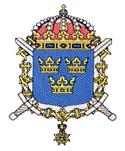
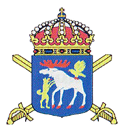
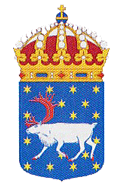
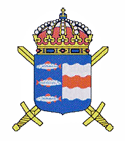
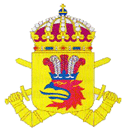
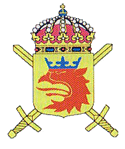

Life Guards of Foot, I1
Göta Guards of Foot, I2
Garde du Corps
Jämtland Rifle Regiment, I23/I5
Norrbotten Regiment, I19
Västernorrland Regiment, I21
North Scanian Infantry Reg. I6
South Scanian Infantry Reg. I7





































